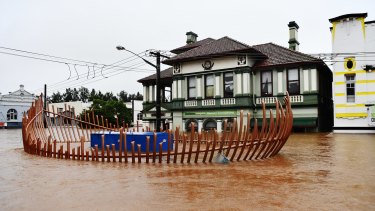We have known since a La Nina weather event was declared for Australia near the end of the nation’s wettest November on record last year that we might confront a summer of extreme rainfall and flooding. But the scale of the deluge that has inundated south-east Queensland and northern NSW in recent days has still come as a shock.
Few people in Australia would be more familiar with the scourge of rising floodwaters than the residents of Lismore, in the Northern Rivers region of NSW, and yet the height of the Wilson River there yesterday “really took a lot of people by surprise”, according to the city’s mayor, Steve Krieg. “Lismore is used to flooding, but no one could predict or prepare for what we’ve experienced in the past 24 hours,” he said.

Severe flooding has hit Lismore in northern NSW.Credit:Elise Derwin
The downpour had moved south from Queensland, where eight people have died, more than 15,000 homes have been inundated, 1000 schools closed and evacuation centres swamped. “No one has seen this amount of rain in such a short time in our entire south-east catchment zone,” said Queensland Premier Annastacia Palaszczuk.
Before the rain eased, the Brisbane River rose close to the record level that devastated parts of the city’s CBD in 2011, but the fact this deluge stopped just short of the record was of little consolation for the thousands of homes and businesses flooded. Queenslanders know the recovery will be long and expensive. The floods of 11 years ago claimed the lives of more than 30 people and damage was estimated at $2.38 billion.
Australia was in the grip of an exceptionally strong La Nina in 2011. Conditions in the Indian Ocean that amplified the event 11 years ago are in a neutral phase this time, and experts had expected this would bring a milder La Nina. But as the Climate Council notes, “these short-term cyclical drivers are now occurring in the context of a warming climate”. Human-induced climate change means “all weather now occurs in an atmosphere that is warmer, wetter and more energetic”, prompting, in turn, a dramatic increase in “the heaviest and most damaging rainfall events” and the risk of dangerous floods.
That predicted scenario is playing out, tragically, in Queensland and NSW at a time when many Australian communities are still recovering from the pandemic and the bushfire disaster of the summer of 2019-20. That just two years ago we were suffering the nation’s hottest and driest year on record shows the extremes of the climate crisis are folding in on each other.
Loading
In a sobering report released yesterday, the Intergovernmental Panel on Climate Change secretariat said: “Increased heatwaves, droughts and floods are already exceeding plants’ and animals’ tolerance thresholds, driving mass mortalities in species such as trees and corals. These weather extremes are occurring simultaneously, causing cascading impacts that are increasingly difficult to manage.”
Mitigation measures are critical and must be pursued vigorously, but the crisis is such that we must also adapt our lifestyles in response. The disaster recovery funds that the Australian government provided for bushfire victims were extended yesterday to those affected by the Queensland and NSW floods. A Deloitte Access Economics report late last year said the cost of natural disasters was $38 billion a year, and that would grow to $73 billion a year by 2060. Insurance companies are also wincing at the future cost of natural disasters.


